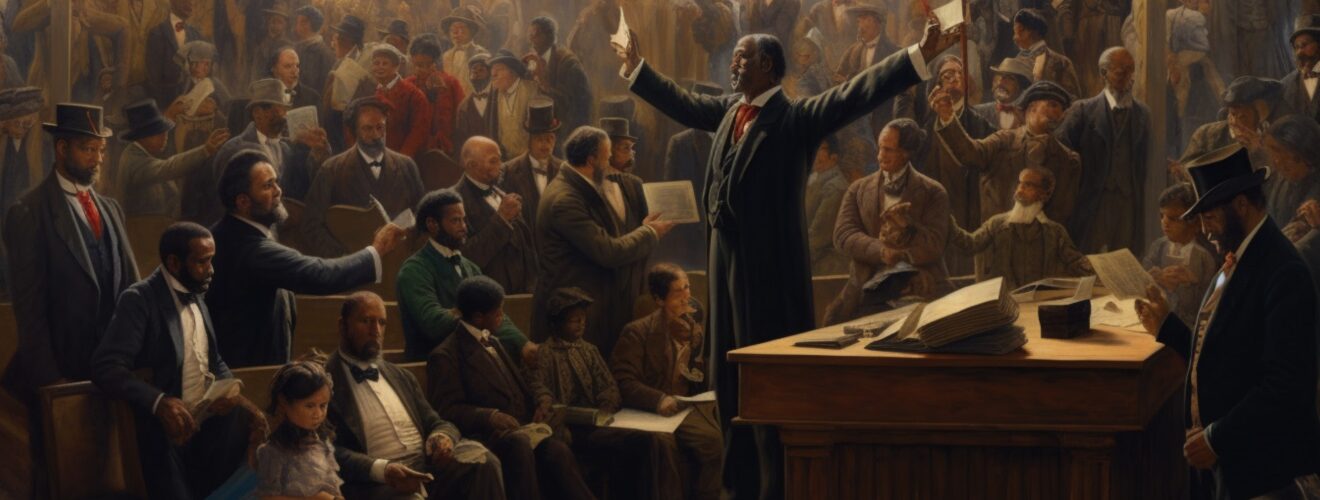Reconstruction Era in American History

The Reconstruction Era in American history refers to the period following the American Civil War (1861–1865) when efforts were made to rebuild and transform the Southern United States. It lasted from approximately 1865 to 1877 and aimed to address issues related to the reintegration of Southern states into the Union, the status of formerly enslaved individuals, and the rebuilding of the Southern economy. Here are key aspects of the Reconstruction Era:
1. Presidential Reconstruction (1865–1867)
- President Andrew Johnson’s approach focused on leniency towards the Southern states that seceded.
- Southern states were required to ratify the 13th Amendment (abolishing slavery) and nullify secession ordinances to rejoin the Union.
2. Freedmen’s Bureau (1865)
- Established by Congress, the Freedmen’s Bureau aimed to assist newly emancipated slaves and impoverished whites in the South.
- It provided education, medical care, and assistance in securing employment and land.
3. Reconstruction Amendments
- The 13th Amendment (1865) abolished slavery.
- The 14th Amendment (1868) granted equal protection under the law and citizenship to all persons born or naturalized in the U.S.
- The 15th Amendment (1870) granted voting rights regardless of race or color.
4. Radical Reconstruction (1867–1877)
- Congressional Republicans took a more assertive stance, implementing stricter measures in the Southern states.
- The Reconstruction Acts of 1867 divided the South into military districts governed by Union generals.
5. Southern State Governments
- New state governments were established in the South, with the participation of African Americans and white Republicans.
- Some African Americans held political offices during this period.
6. Black Codes and Jim Crow Laws
- Southern states enacted restrictive laws known as Black Codes to control the labor and behavior of African Americans.
- Jim Crow laws later institutionalized racial segregation and disenfranchisement.
7. Reconstruction Policies
- Policies aimed at economic recovery included land redistribution and the establishment of the sharecropping system.
- However, these efforts faced challenges and did not result in significant land reform.
8. Ku Klux Klan and Violence
- The Ku Klux Klan and other white supremacist groups sought to undermine the political and economic gains of African Americans through intimidation and violence.
9. Compromise of 1877
- The disputed presidential election of 1876 led to the Compromise of 1877, marking the end of Reconstruction.
- Federal troops were withdrawn from the South, and Southern states regained control over their governments.
10. Legacy: – Reconstruction left a mixed legacy. It brought about significant advancements in civil rights, education, and political participation for African Americans. – However, the failure to address economic disparities and protect civil rights paved the way for the later Jim Crow era.
The Reconstruction Era was a complex and tumultuous period that sought to address the aftermath of the Civil War and redefine the relationship between the federal government and the Southern states. It remains a crucial chapter in the ongoing struggle for civil rights and racial equality in the United States.
The Reconstruction Era in American history refers to the period following the American Civil War (1861–1865) when efforts were made to rebuild and transform the Southern United States. It lasted from approximately 1865 to 1877 and aimed to address issues related to the reintegration of Southern states into the Union, the status of formerly enslaved individuals, and the rebuilding of the Southern economy. Here are key aspects of the Reconstruction Era:
1. Presidential Reconstruction (1865–1867)
- President Andrew Johnson’s approach focused on leniency towards the Southern states that seceded.
- Southern states were required to ratify the 13th Amendment (abolishing slavery) and nullify secession ordinances to rejoin the Union.
2. Freedmen’s Bureau (1865)
- Established by Congress, the Freedmen’s Bureau aimed to assist newly emancipated slaves and impoverished whites in the South.
- It provided education, medical care, and assistance in securing employment and land.
3. Reconstruction Amendments
- The 13th Amendment (1865) abolished slavery.
- The 14th Amendment (1868) granted equal protection under the law and citizenship to all persons born or naturalized in the U.S.
- The 15th Amendment (1870) granted voting rights regardless of race or color.
4. Radical Reconstruction (1867–1877)
- Congressional Republicans took a more assertive stance, implementing stricter measures in the Southern states.
- The Reconstruction Acts of 1867 divided the South into military districts governed by Union generals.
5. Southern State Governments
- New state governments were established in the South, with the participation of African Americans and white Republicans.
- Some African Americans held political offices during this period.
6. Black Codes and Jim Crow Laws
- Southern states enacted restrictive laws known as Black Codes to control the labor and behavior of African Americans.
- Jim Crow laws later institutionalized racial segregation and disenfranchisement.
7. Reconstruction Policies
- Policies aimed at economic recovery included land redistribution and the establishment of the sharecropping system.
- However, these efforts faced challenges and did not result in significant land reform.
8. Ku Klux Klan and Violence
- The Ku Klux Klan and other white supremacist groups sought to undermine the political and economic gains of African Americans through intimidation and violence.
9. Compromise of 1877
- The disputed presidential election of 1876 led to the Compromise of 1877, marking the end of Reconstruction.
- Federal troops were withdrawn from the South, and Southern states regained control over their governments.
10. Legacy: – Reconstruction left a mixed legacy. It brought about significant advancements in civil rights, education, and political participation for African Americans. – However, the failure to address economic disparities and protect civil rights paved the way for the later Jim Crow era.
The Reconstruction Era was a complex and tumultuous period that sought to address the aftermath of the Civil War and redefine the relationship between the federal government and the Southern states. It remains a crucial chapter in the ongoing struggle for civil rights and racial equality in the United States.








